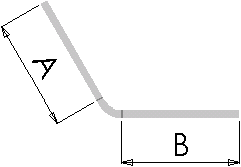Bend allowance and bend deduction calculations are methods you can choose to determine the flat length of sheet stock to give the desired dimension of the bent part. Other methods include bend tables, K-Factor, and bend calculation.
Bend Allowance and Bend Deduction Calculations
The following illustration shows A and B, used to calculate the bend allowance:

The following equation is used to calculate the total flat length for bend allowance:
Lt = A + B + BA
where:
- Lt is the total flat length
- BA is the bend allowance value
The following illustration shows A, B, and BD, used to calculate the bend deduction:

The following equation is used to determine the total flat length for bend deduction values:
Lt = A + B - BD
where:
- Lt is the total flat length
- BD is the bend deduction value
You must measure the bend deduction (BD) from the virtual sharp.
Bend Allowance and Bend Deduction Value
You can specify an explicit bend allowance or bend deduction for any sheet metal bend by entering the value when you create the bend.
By definition, the bend allowance is the arc length of the bend as measured along the neutral axis of the material. By definition, the bend deduction is the difference between the bend allowance and twice the outside setback.
